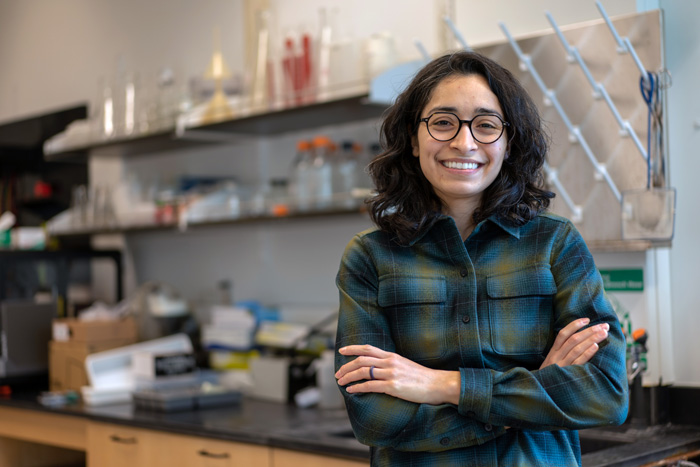NSF Awards Crystal Reynaga $450,000 For Upcoming Research

Photo by Dan Loh.
Project will study how frogs and toads navigate complex environments
by Tony Moore
Assistant Professor of Biology Crystal Reynaga was recently awarded a grant of $456,522 for her project "BRC-BIO: Trade-offs in Locomotor Performance: Comparing Hoppers and Jumpers in Variable Environments." The grant, part of the National Science Foundation’s (NSF) Building Research Capacity of New Faculty in Biology (BRC-BIO) program, aims to disentangle what physiological fine-tuned adjustments frogs make in the face of various obstacles.
Reynaga says that the grant will not only allow her to investigate live, whole-body movements of the frogs but also to set her focus at the organ and tissue level by investigating the underlying muscle and tendon, thereby unlocking an understanding of their roles in energy recovery after environmental disruptions.
“As a biomechanist, I integrate principles of classical Newtonian physics with aspects in physiology, anatomy and neuroscience to understand how organisms move,” Reynaga says, adding that her specific interest lies in how organisms navigate complex environments. “Quite often, the strategies animals use to achieve such unique movements are far more efficient than our own. Frogs are a perfect model to study given the diversity in how they move, from swimming to hopping and jumping and even walking or running.”
Reynaga says the work will inform a new understanding of how organisms adapt to ever-changing environments in the context of global change—with the added benefit of potentially aiding in design parameters in engineered systems (like robotics) that deal with environmental disturbance. (On a related note, Reynaga recently co-authored the article “Adapting Small Jumping Robots to Compliant Environments” in the Journal of the Royal Society Interface.)
The project will focus on two species of frogs—cane toads, which are long-distance endurance hoppers, and Cuban tree frogs, which are fast, powerful jumpers. It will quantify and compare the interspecific kinematic variation between these two species in response to environmental obstacles in substrate stiffness.
"We hypothesize that specialized ways of movement, such as jumping and hopping, each have uniquely constrained motor control strategies and muscle-tendon properties," Reynaga says, emphasizing the importance of subtle adaptations in an organism's ability to navigate new habitats and how these adaptations can provide important insights into locomotor specialization. "However, adjustments to locomotor outcomes may be independently tuned through different levels of organization, such as muscle and tendon level."
The grant will also provide student researchers with opportunities to participate in every aspect of the project, from experimental design to data collection, analysis and presentation. Additionally, the grant will enable the lab to travel to advanced imaging facilities at the University of Pennsylvania and the University of Delaware to further study muscle and tendon structures using specialized equipment.
TAKE THE NEXT STEPS
Published April 12, 2023